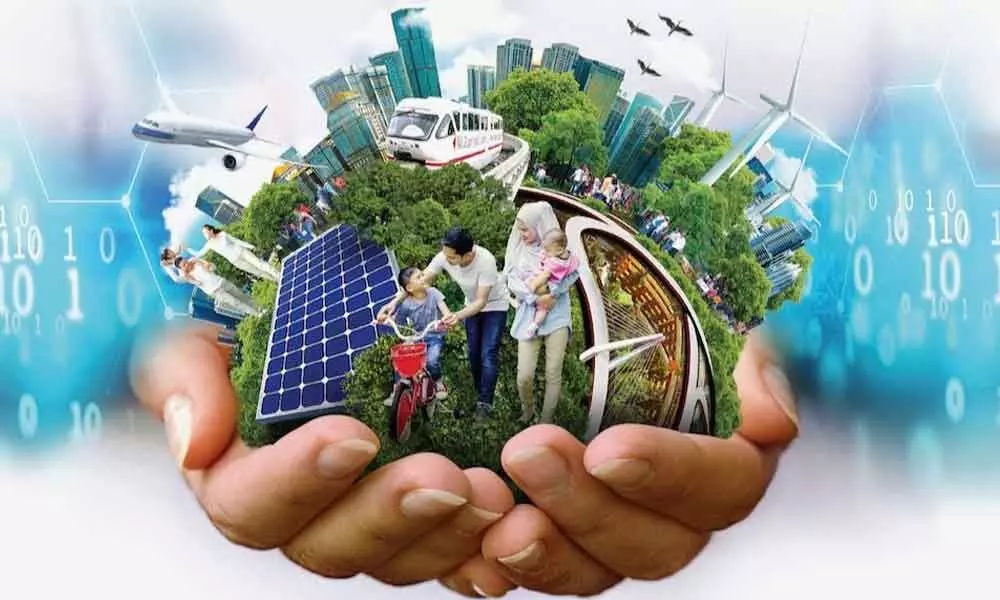Transitioning into a sustainable future

Transitioning into a sustainable future
The 2015 signing of the landmark Paris Agreement at the UN Climate Change Conference -- with a multilateral and worldwide impact on energy transition -- has been picking up pace in the last two years.
The 2015 signing of the landmark Paris Agreement at the UN Climate Change Conference -- with a multilateral and worldwide impact on energy transition -- has been picking up pace in the last two years. Being the world's first comprehensive climate agreement, this accord sets a target of limiting global warming to 2ºC above pre-industrial levels. The good news is that 197 countries have presented their ratification and are enacting legislation, giving tax concessions, and setting carbon footprint reduction objectives to achieve this goal.
Driven by concerns of carbon and other greenhouse gas emissions, consumer groups and corporates too have invested in alternative energies to the tune of US$350 billion per year, thereby reducing fossil fuel use as economic drivers. There are other impactful outcomes of the energy transition process at four levels, that need to be addressed globally.
Environment
Although these pledges are intended to reduce the harmful effects of carbon emissions on the planet, are such initiatives as eco-friendly as they are reckoned to be? It is true that all energy sources have an impact on the environment. Today 80% of the energy stems from fossils and its intensity and impact are known and in discussion.
Studies point out that not all environmental concerns will reduce with the use of renewable energy. For example, hydropower may not impact air quality, but dam construction may lead to floods. Wind power is known to impact the survival of birds and solar power uses a huge amount of land and harmful materials in panel production. So the list is endless.
However, companies are focusing on implementing solutions that can encourage use of renewable energy and limit the negative effects of renewable energy to expand their power capacity. They are now consciously studying the relative environmental impacts of alternative energy sources and comparing them to those of fossil-fuel technologies and spotting opportunities to improve not just energy efficiency, but also reduce the carbon footprint.
Geopolitical landscape
Some moments of truth may emerge in the geopolitical space with the global transformation from fossil-based to zero-carbon energy production. On the one hand, the shift towards green energy may throw cold water on currently existing geopolitical rivalries, encouraging cooperation and reducing rivalry. But wait, the gravity of action may shift to regions rich in renewable energy sources like rare critical minerals such as lithium and cobalt. Unfortunately, these are highly geographically concentrated, and that too in countries that lack effective governance.
In the next two decades, the demand for critical minerals will skyrocket. A 2020 World Bank report says the production of lithium and cobalt may increase by 500 percent by 2050 to meet clean energy demand alone. Explosive situation indeed, if not tackled properly.
Now, let's move away from this doomsday viewpoint. With globally reduced reliance on oil and gas, one can look forward to a potentially high level of global peace dividend; and resultant self-sufficiency in energy in all countries. But what will set apart countries that make use of the situation, is foresight in leadership and policy.
Take for example, how China grabbed the EV opportunity. In 2019, Chinese companies were top suppliers (80%) of the world's output of raw materials for EV batteries. In oil and gas-rich countries too, energy strategies are being planned, ones that will help them get out of dependence on a single resource to run the economy.
Oil & Gas industry
The oil and gas sector has been agile enough to offer cleaner energy. They have already set net-zero-emissions targets and as we speak, are making significant investments in technology to lower their carbon footprint. Today, a company's efforts to supply cleaner energy have a significant impact on its reputation and many are sustaining efforts to decarbonize their operations and their value chains.
The United Arab Emirates is looking at 70 percent decarbonization and 44 percent clean energy power generation by 2050. Climate Action 100+ which is an investors initiative has garnered more than 500 signatories amounting to a combined total of more than $50 trillion in assets under management. In a Deloitte survey on energy transition, more than 90% of oil and gas respondents said their company has or is developing a long-term strategy for a sustainable, low-carbon future. About 50% of oil and gas respondents are already investing in energy efficiency, cleaner fuels to power field operations, and acquiring businesses outside their core focus.
Apart from providing greener energy, the industry is working to minimize its operating costs with strategies to compete with what lies ahead in the new renewable energy-dependent world. It is reviewing its strategies and supply chain to compete in the new market dynamics. With the global population expected to touch the 9-billion mark by 2040, the International Energy Agency IEA's annual study predicts that global energy demand will more than double from today. And along with other accessible renewable energy sources, oil and gas will continue to be in demand.
Global economy
A transformed energy sector will have 122 million jobs in 2050 out of which the renewable energy sector will hire around 42 million people. Qualifications, skills, and occupations under the ambitious 1.5°C scenario are increasingly concentrated in manufacturing, followed by fuel supply. Job opportunities will be created in the manufacturing, engineering, and installation industries. Other related sectors like new product manufacturing, supply chain, and distribution will boost gross domestic product (GDP).
Conclusion
The transition will increase access to energy, create new jobs, and stimulate the economy while protecting the environment. It is likely to boost the global economy and lead to further growth.
According to IRENA (International Renewable Energy Agency), investment in the 1.5°C scenarios is expected to produce a cumulative payback of at least USD 61 trillion by 2050. By then, two-thirds of the total hydrogen will be green – produced with renewable electricity – and one-third blue, produced by natural gas coupled with carbon capture and storage (CCS). Bioenergy will represent 18% of total final energy consumption in 2050.
The problem has many other facets to it. Like, having a proactive governing bodies that work on creating holistic solutions to environmental issues.
Take for instance, the transport issue and the increasing ownership of vehicles leading to the rising use of gas and petrol in the city of Bengaluru. Although the city has a well laid out network of rail and metro transport, the lack of last mile connectivity bars people from using these modes of transportation. Apart from addressing environmental issues, governments need to address seamless connectivity issue and coverage of the routes.
However, let's be realistic and face the fact that for the world, obtaining all of its future energy needs are not solely from renewable sources like sun, wind, and hydropower. Hydrocarbons will continue to play a major role in fuelling economies.
(The author is Energy and Supply Chain Expert & Member of American Petroleum Institute (API) committee. Houston, Texas)











